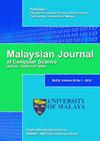WDSAE-DNDT BASED SPEECH FLUENCY DISORDER CLASSIFICATION
IF 1.2
4区 计算机科学
Q4 COMPUTER SCIENCE, ARTIFICIAL INTELLIGENCE
引用次数: 1
Abstract
In this paper, Weight Decorrelated Stacked Autoencoder-Deep Neural Decision Trees (WDSAE-DNDT), a novel hybrid model is proposed for automating the assessment of children’s speech fluency disorders by discerning their disfluencies. In fluency disorder classification, it is imperative to know how each feature contributes to the disorder classification rather than the diagnosis itself and so the depth modified DNDT acts as the best discriminator since it is interpretable by its very nature. The WDSAE presents DNDT with a high-level latent representation of the disfluent speech. A fusion feature vector was built by combining the prosodic cues from disfluent speech segments combined with the WDSAE-based Bottleneck features. The proposed hybrid model was compared with the performance of the experimented baseline models. Further analysis was carried out to check the impact of tree cut points for each feature and epochs on the accuracy of prediction of the hybrid model. The proposed hybrid model when trained on the fusion feature set has shown appreciable improvement in the area under the Receiver Operating Characteristics (ROC) curve, classification accuracy, Kappa statistical value, and Jaccard similarity index. The WDSAE-DNDT demonstrates high precision than the baseline models in setting clinical benchmark to distinguish subjects with dysphemia from those with Specific Language Impairment.基于WDSAE-DNDT的言语流畅性障碍分类
本文提出了一种新的混合模型——加权去相关堆叠式自动编码器深度神经决策树(WDSAE-DNDT),用于通过识别儿童的不流利性来自动评估儿童的言语流利性障碍。在流利性障碍分类中,必须知道每个特征是如何对障碍分类做出贡献的,而不是诊断本身,因此深度修正的DNDT是最好的鉴别器,因为它可以从本质上进行解释。WDSAE为DNDT提供了不流畅语音的高级潜在表示。通过将来自不流畅语音片段的韵律线索与基于WDSAE的瓶颈特征相结合,构建了融合特征向量。将所提出的混合模型与实验的基线模型的性能进行了比较。进行了进一步的分析,以检查每个特征和时期的树切割点对混合模型预测准确性的影响。当在融合特征集上训练时,所提出的混合模型在接收器操作特征(ROC)曲线下的区域、分类精度、Kappa统计值和Jaccard相似性指数方面显示出显著的改进。WDSAE-DNDT在设定临床基准以区分吞咽困难受试者和特定语言障碍受试者方面比基线模型具有更高的准确性。
本文章由计算机程序翻译,如有差异,请以英文原文为准。
求助全文
约1分钟内获得全文
求助全文
来源期刊

Malaysian Journal of Computer Science
COMPUTER SCIENCE, ARTIFICIAL INTELLIGENCE-COMPUTER SCIENCE, THEORY & METHODS
CiteScore
2.20
自引率
33.30%
发文量
35
审稿时长
7.5 months
期刊介绍:
The Malaysian Journal of Computer Science (ISSN 0127-9084) is published four times a year in January, April, July and October by the Faculty of Computer Science and Information Technology, University of Malaya, since 1985. Over the years, the journal has gained popularity and the number of paper submissions has increased steadily. The rigorous reviews from the referees have helped in ensuring that the high standard of the journal is maintained. The objectives are to promote exchange of information and knowledge in research work, new inventions/developments of Computer Science and on the use of Information Technology towards the structuring of an information-rich society and to assist the academic staff from local and foreign universities, business and industrial sectors, government departments and academic institutions on publishing research results and studies in Computer Science and Information Technology through a scholarly publication. The journal is being indexed and abstracted by Clarivate Analytics'' Web of Science and Elsevier''s Scopus
 求助内容:
求助内容: 应助结果提醒方式:
应助结果提醒方式:


